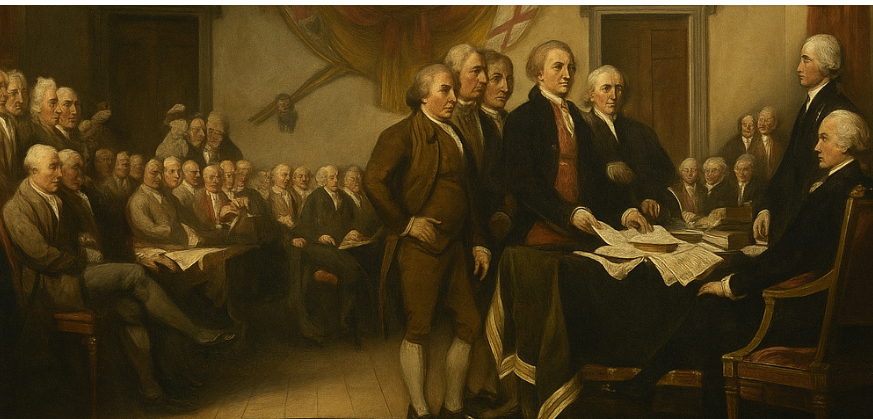Congress to PrumpTutin: Please Sir, May We Watch Silently?
So, Can the President Slap Tariffs on Whatever He Wants?
A lot of folks—including trump—think the President can just wake up, spill his coffee, and slap tariffs on anything he’s mad at that day. Not quite.
The Constitution gives Congress the power to impose taxes and tariffs. It’s their job, not the President’s. But over time, Congress has handed the President some hefty levers to pull when it comes to trade.

Here’s where a lot of confusion comes in. There’s a difference between can and may, and it matters a hell of a lot when we’re talking about presidential power.
Can is about whether something’s possible in practice. The President can pick up a pen and sign an order imposing tariff. He can tell Customs to collect money at the ports. Physically and practically, he can do it.
But may is about permission. It’s about whether the law actually allows him to do it. And sometimes that permission comes from old, arcane laws that Congress passed decades ago—laws nobody paid much attention to until a president like PrumpTutin came along and swung them like a club.
That’s the heart of this whole debate. PrumpTutin acts like can and may are the same thing. They’re not. Just because a president can do something doesn’t mean he may do it legally. But as we’ve seen, he might go ahead and do it anyway—and wait to see if anyone’s got the guts to stop him.
Basically, Congress said: Look, if something’s threatening national security, or another country’s playing dirty, or there’s an emergency, you can raise tariffs. So Presidents can—and do—mess with tariffs, but only because Congress allowed it.
Here’s how it played out with PrumpTutin and his tariffs:
- Steel and Aluminum (2018)
Trump imposed a 25% tariff on steel and 10% on aluminum from many countries.- Legal authority? Yes — he used Section 232 of the Trade Expansion Act of 1962, which lets the President restrict imports that threaten national security. Whether steel imports really threatened national security was, to say the least, controversial. Plenty of folks argued it was just protectionism in disguise, aimed at boosting U.S. producers and scoring political points in steel-producing states. Lawsuits followed, and trading partners retaliated, leading to higher costs for industries that rely on steel and aluminum, like construction and auto manufacturing.
- China Tariffs (2018-2020)
Trump hit hundreds of billions of dollars’ worth of Chinese goods with tariffs ranging from 10% to 25%.- Legal authority? Yes — under Section 301 of the Trade Act of 1974, which allows the President to retaliate against unfair trade practices. Trump argued China was stealing U.S. intellectual property and engaging in unfair trade. The tariffs sparked a trade war that dragged on for years, rattling markets and leaving U.S. farmers caught in the crossfire. China responded with tariffs of its own, especially on agricultural products, which forced the U.S. government to shell out billions in aid to American farmers who lost their markets.
- Tariff Threats on Mexico (2019)
Trump threatened tariffs on all goods from Mexico unless Mexico cracked down on migration to the U.S.- Legal authority? Dubious. He floated using the International Emergency Economic Powers Act (IEEPA), passed in 1977, to justify it, claiming illegal immigration posed an “unusual and extraordinary threat.” Many legal experts rolled their eyes, arguing the statute was meant for genuine national security crises—not immigration policy. In the end, the tariffs were never imposed because Mexico agreed to certain measures on migration, but the whole episode highlighted how tariff threats were becoming a presidential tool for issues far beyond trade.
- Tariffs on Washing Machines and Solar Panels (2018)
Trump imposed tariffs on imported washing machines (up to 50%) and solar panels (up to 30%).- Legal authority? Yes — under Section 201 of the Trade Act of 1974, which allows temporary “safeguard” tariffs if a surge in imports seriously injures domestic producers. Here, the move was more legally straightforward. Domestic manufacturers like Whirlpool had been complaining that cheap imports were gutting their businesses. Still, consumers wound up paying higher prices for washers and dryers, and the solar industry warned it would slow the shift to renewable energy.
Now, yes, there are supposed to be safeguards in place—rules, legal tests, oversight—to keep any president from using tariffs like a personal hammer. But PrumpTutin has shown he’s perfectly willing to blow right through those safeguards, either stretching the laws to their outer limits or daring anyone to stop him.
And courts do sometimes try. Legal challenges cropped up after many of these tariffs, especially the steel and aluminum ones. Critics argued that the President was abusing national security justifications for what were basically economic or political goals. Judges, though, often hesitate to second-guess national security decisions, so Trump’s tariffs largely stood, even if they triggered a mountain of litigation.
Meanwhile, Congress theoretically has the power to rein the President back in. They could amend the laws, claw back authority, or impose stricter definitions on what counts as a “national security threat.” But let’s be honest: Congress—especially the Republicans—has shown almost no courage to stop PrumpTutin. They talk a big game about separation of powers, but when it comes time to challenge him, they melt into the wallpaper. Nobody wants to take responsibility for lifting tariffs and then getting blamed if American industries start complaining.
And it’s not just tariffs. This is the same guy who saw nothing wrong with asking for—and receiving—a $747 million private jet from Qatar, a Boeing 747 customized like a flying palace, handed over like a party favor for services rendered. Whether it’s trade wars or personal perks, PrumpTutin behaves like the rules are for everyone else. And the Republicans in Congress mostly stand there watching, afraid to raise so much as an eyebrow.
So here we are: the President can set tariffs, but only because Congress handed him the keys through specific laws—some of them written over a century ago. It’s not some magical power that comes with the Oval Office. Congress still owns the car—even if PrumpTutin, or anyone else, is determined to drive it straight through the guardrails. And the guardrails, frankly, are looking a little bent.
Tariffs may sound like a neat way to “punish” other countries, but the costs always land on American businesses and consumers. Steel tariffs make everything from cars to canned beer more expensive. China tariffs hike prices on electronics, clothing, and countless other goods. And even the mere threat of tariffs can spook markets, freeze investment, and strain alliances.
Bottom line: tariffs are a tool—sometimes necessary, sometimes reckless. But they’re supposed to be wielded carefully, with Congress as the ultimate backstop. The problem is, we’ve seen how a determined President like PrumpTutin can pick up that tool—and any other perk he can hustle—and start swinging it like a sledgehammer, while Congress stands there, terrified of getting hit by the backlash.

